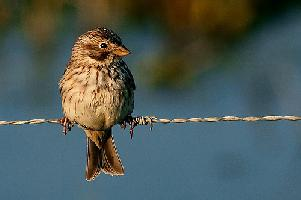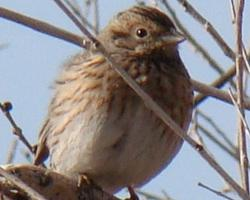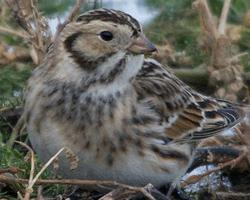
Description de l'animal
The Corn Bunting (Emberiza calandra) is a passerine bird that is a member of the bunting family, Emberizidae. It is recognized for its distinctive appearance and melodious song, making it a fascinating subject of study for ornithologists and bird enthusiasts alike. This bird species is predominantly found across the European continent, stretching into parts of Asia and North Africa, thriving in open, agricultural landscapes.Physically, the Corn Bunting is a robust bird, with a body length that can range from 16 to 19 centimeters, making it one of the larger species within its family. It has a rather stout body, a thick, conical beak designed for seed-eating, and a relatively short tail. The plumage of the Corn Bunting is predominantly a mixture of brown and grey tones, with darker streaks across the back and lighter, sometimes almost whitish, underparts. This cryptic coloration helps it blend into its farmland and grassland habitats, providing camouflage from predators.
One of the most distinctive features of the Corn Bunting is its song. The male's song, often described as a jangling of keys, is a series of metallic notes that can be heard throughout its territory, especially during the breeding season. This unique song serves as a means of attracting a mate and establishing territorial boundaries.
Corn Buntings are ground-nesting birds, with a preference for laying their eggs in the cover of tall grasses or crops. Their nests are typically constructed from grasses and lined with finer materials. The diet of the Corn Bunting is predominantly granivorous, consisting mainly of seeds, but during the breeding season, they will also consume insects to provide additional protein to their young.
The breeding season for Corn Buntings starts in late April and can extend through July. During this period, females lay between three to five eggs, which are incubated for about two weeks before hatching. The young are then fed by both parents and fledge approximately two weeks after hatching.
Despite its widespread distribution, the Corn Bunting has experienced significant population declines in parts of its range, primarily due to modern agricultural practices that have led to the loss of its natural habitat. Changes in land use, such as the intensification of agriculture and the use of pesticides, have reduced the availability of seeds and insects for feeding, as well as suitable nesting sites.
Conservation efforts for the Corn Bunting involve promoting agricultural practices that are more wildlife-friendly, such as maintaining field margins and hedgerows and reducing pesticide usage. These measures can help ensure the survival of this species, allowing it to continue filling the countryside with its distinctive song.
In summary, the Corn Bunting is a fascinating bird species with unique characteristics that make it a notable member of the avian world. Despite facing challenges from human activities, ongoing conservation efforts offer hope for its future, highlighting the importance of sustainable agricultural practices in preserving biodiversity.
Animaux similaires
Nouvelles photos d'animaux
Top 10 des animaux
- Dolphin gull (Leucophaeus scoresbii)
- Diana monkey (Cercopithecus diana)
- Moustached guenon (Cercopithecus cephus)
- Galápagos tortoise (Geochelone nigra complex)
- Japanese macaque (Macaca fuscata)
- Stone loach (Barbatula barbatula)
- Russian tortoise (Testudo horsfieldii)
- Greek tortoise (Testudo graeca)
- Common flying dragon (Draco volans)
- Vendace (Coregonus albula)


